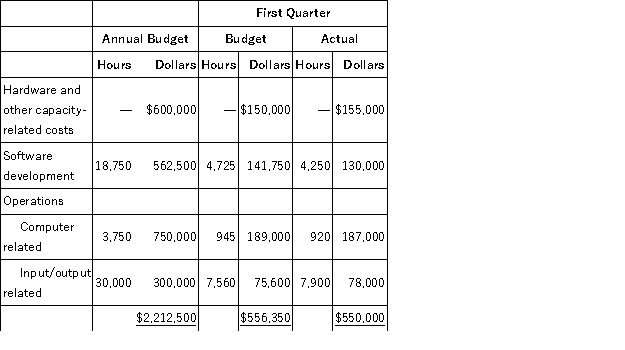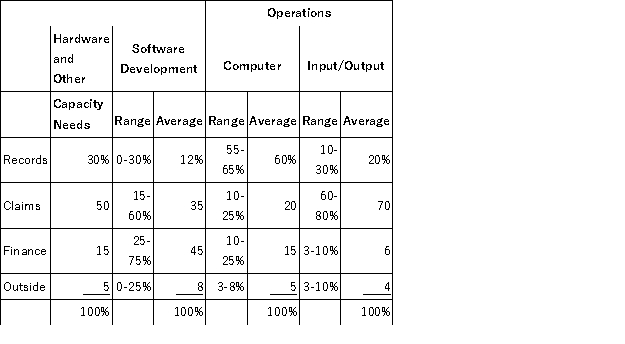The Independent Underwriters Insurance Co IUI Currently Sells the Equivalent of Its Expansion Capacity to Two
The Independent Underwriters Insurance Co. (IUI) established a systems department two years ago to implement and operate its information technology system. IUI believed that its own system would be more cost-effective than the service bureau it had been using.
IUI's three departments - claims, records, and finance - have different requirements with respect to hardware and other capacity-related resources and operating resources. The system was designed to recognize these differing demands. It was also designed to meet IUI's long-term capacity. The excess capacity designed into the system is being sold to outside users until IUI needs it. The estimated resource requirements used to design and implement the system are shown in the following schedule. IUI currently sells the equivalent of its expansion capacity to a few outside clients.
When the system became operational, management decided to redistribute total expenses of the systems department to the user departments based upon actual computer time used. The actual costs for the first quarter of the current fiscal year were distributed to the user departments as follows: The three user departments have complained about the cost distribution since the systems department was established. The records department's monthly costs have been as much as three times the costs experienced with the service bureau. The finance department is concerned about the costs distributed to the outside user category, because these allocated costs form the basis for the fees billed to outside clients.
James Dale, IUI's controller, decided to review the distribution method by which the systems department's costs have been allocated for the past two years. The additional information he gathered for his review is reported in Tables 1, 2, and 3. Dale has concluded that the method of cost distribution should be changed to reflect more directly the actual benefits received by the departments. He believes that hardware and capacity-related costs should be allocated to the user departments in proportion to their planned, long-term needs. Any difference between actual and budgeted hardware costs should remain with the systems department.
The remaining costs for software development and operations would be charged to the user departments based upon actual hours used. A predetermined hourly rate based upon the annual budget data would be used. The hourly rates proposed for the current fiscal year are as follows: Dale plans to use first-quarter activity and cost data to illustrate his recommendations. The recommendations will be presented to the systems department and the user departments for their comments and reactions. He then expects to present his recommendations to management for approval.
Required:
a. Prepare a schedule to show how the actual first-quarter costs of the systems department will be charged to the users if James Dale's recommended method is adopted.
b. Explain whether James Dale's recommended system for charging costs to the user departments will
(i) Improve cost control in the systems department.
(ii) Improve planning and cost control in the user departments.
(iii) Be a more equitable basis for charging costs to user departments.
Table1
SystemsDepartmentCostsandActivityLevels  Table2
Table2
HistoricalUtilizationbyUsers  Table3
Table3
UtilizationofSystemsDepartment'sServicesforFirstQuarter
(in Hours)
This problem, while couched as a cost allocation issue, is in effect a transfer pricing problem.
Correct Answer:
Verified
b. (i) The new charging system is ...
View Answer
Unlock this answer now
Get Access to more Verified Answers free of charge
Q14: Allocating Overhead versus Direct Tracing
Nixon &
Q15: Pluton makes particular plastics for sale
Q16: Eastern University prides itself on providing faculty
Q17: Peluso Company, a manufacturer of snowmobiles, is
Q18: Which of the following are true about
Q20: Pluton makes particular plastics for sale
Q21: Cost Allocations can Change the Relative Profitability
Q22: Encryption, Inc. (EI), sells and maintains fax
Q23: Telstar Electronics manufactures and imports a wide
Q24: Bio Labs is a genetic engineering firm
Unlock this Answer For Free Now!
View this answer and more for free by performing one of the following actions

Scan the QR code to install the App and get 2 free unlocks

Unlock quizzes for free by uploading documents